Overview and Recent Developments of the Frascati Laser for Acceleration and Multidisciplinary Experiments Laser Facility at SPARC_LAB
Abstract
1. Introduction
2. Laser Layout and Features
2.1. Front End
2.2. Main Beamline
2.3. Auxiliary Beamline
2.4. Probe Beamline
3. Experimental Campaigns at FLAME
3.1. Auxiliary Beamline Target Area at FLAME
3.1.1. Laser-Guiding Experimental Campaign
3.1.2. Target Production
3.1.3. Experimental GEM Area Diagnostics
Laser Diagnostics
STARK Broadening Plasma Density Measurements
3.2. Main Beamline Target Area at FLAME
- Electron acceleration through LWFA in a gaseous target, which can be configured as a gas jet or a gas cell/capillary.
- Generation of fast electron and light ion bunches from interactions with solid targets using the TNSA technique.
3.2.1. Experimental TET Area Diagnostics
Laser Diagnostics
Magnetic Spectrometer
EOS Detector
Interferometry
BCM Diagnostics
X-CCD Diagnostics
Thomson Diagnostics
Scintillator Screen Diagnostics
3.2.2. Laser–Gas Jet Interaction Experimental Campaign
3.2.3. Laser–Solid Target Interaction Experimental Campaign
Fast Electron Beams Detection
Electromagnetic Pulses Detection
Electron–Proton Beams Detection and Correlation
4. Conclusions
Author Contributions
Funding
Institutional Review Board Statement
Informed Consent Statement
Data Availability Statement
Acknowledgments
Conflicts of Interest
References
- Strickland, D.; Mourou, G. Compression of amplified chirped optical pulses. Opt. Commun. 1985, 55, 447–449. [Google Scholar] [CrossRef]
- Danson, C.; Haefner, C.; Bromage, J.; Butcher, T.; Chanteloup, J.; Chowdhury, E.; Galvanauskas, A.; Gizzi, L.; Hein, J.; Hillier, D.; et al. Petawatt and exawatt class lasers worldwide. High Power Laser Sci. Eng. 2019, 7, e54. [Google Scholar] [CrossRef]
- Roth, M.; Cowan, T.; Key, M.; Hatchett, S.; Brown, C.; Fountain, W.; Johnson, J.; Pennington, D.; Snavely, R.; Wilks, S.; et al. Fast ignition by intense laser-accelerated proton beams. Phys. Rev. Lett. 2001, 86, 436. [Google Scholar] [CrossRef] [PubMed]
- Bartal, T.; Foord, M.; Bellei, C.; Key, M.; Flippo, K.; Gaillard, S.; Offermann, D.; Patel, P.; Jarrott, L.; Higginson, D.; et al. Focusing of short-pulse high-intensity laser-accelerated proton beams. Nat. Phys. 2012, 8, 139–142. [Google Scholar] [CrossRef]
- Ledingham, K.; Galster, W. Laser-driven particle and photon beams and some applications. New J. Phys. 2010, 12, 045005. [Google Scholar] [CrossRef]
- Macchi, A.; Borghesi, M.; Passoni, M. Ion acceleration by superintense laser-plasma interaction. Rev. Mod. Phys. 2013, 85, 751–793. [Google Scholar] [CrossRef]
- Esarey, E.; Schroeder, C.B.; Leemans, W.P. Physics of laser-driven plasma-based electron accelerators. Rev. Mod. Phys. 2009, 81, 1229–1285. [Google Scholar] [CrossRef]
- Remington, B.; Arnett, D.; Paul, R.; Drake; Takabe, H. Modeling astrophysical phenomena in the laboratory with intense lasers. Science 1999, 284, 1488–1493. [Google Scholar] [CrossRef]
- Gizzi, L. Laser-Driven Sources of High Energy Particles and Radiation; Springer: Berlin/Heidelberg, Germany, 2019; pp. 1–24. [Google Scholar] [CrossRef]
- Higginson, A.; Gray, R.; King, M.; Dance, R.; Williamson, S.; Butler, N.; Wilson, R.; Capdessus, R.; Armstrong, C.; Green, J.; et al. Near-100 MeV protons via a laser-driven transparency-enhanced hybrid acceleration scheme. Nat. Commun. 2018, 9, 724. [Google Scholar] [CrossRef]
- Gonsalves, A.; Nakamura, K.; Daniels, J.; Benedetti, C.; Pieronek, C.; De Raadt, T.; Steinke, S.; Bin, J.; Bulanov, S.; Van Tilborg, J.; et al. Petawatt laser guiding and electron beam acceleration to 8 GeV in a laser-heated capillary discharge waveguide. Phys. Rev. Lett. 2019, 122, 084801. [Google Scholar] [CrossRef]
- Giulietti, A. Laser-driven particle acceleration for radiobiology and radiotherapy: Where we are and where we are going. In Proceedings of the Medical Applications of Laser-Generated Beams of Particles IV: Review of Progress and Strategies for the Future, Prague, Czech Republic, 24–25 April 2017; SPIE: Bellingham, WA, USA, 2017; Volume 10239, p. 1023904. [Google Scholar]
- Labate, L.; Palla, D.; Panetta, D.; Avella, F.; Baffigi, F.; Brandi, F.; Di Martino, F.; Fulgentini, L.; Giulietti, A.; Köster, P.; et al. Toward an effective use of laser-driven very high energy electrons for radiotherapy: Feasibility assessment of multi-field and intensity modulation irradiation schemes. Sci. Rep. 2020, 10, 17307. [Google Scholar] [CrossRef] [PubMed]
- Andreassi, M.G.; Borghini, A.; Pulignani, S.; Baffigi, F.; Fulgentini, L.; Koester, P.; Cresci, M.; Vecoli, C.; Lamia, D.; Russo, G.; et al. Radiobiological effectiveness of ultrashort laser-driven electron bunches: Micronucleus frequency, telomere shortening and cell viability. Radiat. Res. 2016, 186, 245–253. [Google Scholar] [CrossRef]
- Ferrario, M.; Alesini, D.; Anania, M.; Bacci, A.; Bellaveglia, M.; Bogdanov, O.; Boni, R.; Castellano, M.; Chiadroni, E.; Cianchi, A.; et al. SPARC_LAB present and future. Nucl. Instrum. Methods Phys. Res. B 2013, 309, 183–188. [Google Scholar] [CrossRef]
- Ferrario, M.; Assmann, R.W.; Avaldi, L.; Bolognesi, P.; Catalano, R.; Cianchi, A.; Cirrone, P.; Falone, A.; Ferro, T.; Gizzi, L. EuPRAXIA Advanced Photon Sources PNRR_EuAPS Project; Technical Report; INFN: Frascati, Italy, 2023. [Google Scholar]
- Assmann, R.; Weikum, M.; Akhter, T.; Alesini, D.; Alexandrova, A.; Anania, M.; Andreev, N.; Andriyash, I.; Artioli, M.; Aschikhin, A.; et al. EuPRAXIA Conceptual Design Report. Eur. Phys. J. Spec. Top. 2020, 229, 3675–4284. [Google Scholar]
- Wilke, I.; MacLeod, A.; Gillespie, W.; Berden, G.; Knippels, G.; Van Der Meer, A. Single-shot electron-beam bunch length measurements. Phys. Rev. Lett. 2002, 88, 124801. [Google Scholar] [CrossRef] [PubMed]
- Pompili, R.; Anania, M.; Bisesto, F.; Botton, M.; Castellano, M.; Chiadroni, E.; Cianchi, A.; Curcio, A.; Ferrario, M.; Galletti, M.; et al. Femtosecond dynamics of energetic electrons in high intensity laser-matter interactions. Sci. Rep. 2016, 6, 35000. [Google Scholar] [CrossRef]
- Pompili, R.; Anania, M.; Bisesto, F.; Botton, M.; Castellano, M.; Chiadroni, E.; Cianchi, A.; Curcio, A.; Ferrario, M.; Galletti, M.; et al. Sub-picosecond snapshots of fast electrons from high intensity laser-matter interactions. Opt. Express 2016, 24, 29512–29520. [Google Scholar] [CrossRef]
- Bisesto, F.; Anania, M.; Botton, M.; Chiadroni, E.; Cianchi, A.; Curcio, A.; Ferrario, M.; Galletti, M.; Pompili, R.; Schleifer, E.; et al. Novel single-shot diagnostics for electrons from laser-plasma interaction at SPARC_LAB. Quantum Beam Sci. 2017, 1, 13. [Google Scholar] [CrossRef]
- Pompili, R.; Anania, M.; Bisesto, F.; Botton, M.; Chiadroni, E.; Cianchi, A.; Curcio, A.; Ferrario, M.; Galletti, M.; Henis, Z.; et al. Ultrafast evolution of electric fields from high-intensity laser-matter interactions. Sci. Rep. 2018, 8, 3243. [Google Scholar] [CrossRef]
- Bisesto, F.; Anania, M.; Bellaveglia, M.; Chiadroni, E.; Cianchi, A.; Costa, G.; Curcio, A.; Di Giovenale, D.; Di Pirro, G.; Ferrario, M.; et al. The FLAME laser at SPARC_LAB. Nucl. Instrum. Methods Phys. Res. A 2018, 909, 452–455. [Google Scholar] [CrossRef]
- Amplitude Laser. 2024. Available online: https://amplitude-laser.com/products/femtosecond-lasers/lasers-for-science/pulsar-pw/ (accessed on 1st March 2024).
- Galimberti, M.; Bisesto, F.G.; Galletti, M. Innovative single-shot 2D pulse front tilt diagnostic. High Power Laser Sci. Eng. 2021, 9, e16. [Google Scholar] [CrossRef]
- Biagioni, A.; Anania, M.; Arjmand, S.; Behar, E.; Costa, G.; Del Dotto, A.; Ferrario, M.; Galletti, M.; Lollo, V.; Pellegrini, D.; et al. Gas-filled capillary-discharge stabilization for plasma-based accelerators by means of a laser pulse. Plasma Phys. Control. Fusion 2021, 63, 115013. [Google Scholar] [CrossRef]
- Curcio, A.; Bisesto, F.; Costa, G.; Biagioni, A.; Anania, M.; Pompili, R.; Ferrario, M.; Petrarca, M. Modeling and diagnostics for plasma discharge capillaries. Phys. Rev. E 2019, 100, 053202. [Google Scholar] [CrossRef]
- Biagioni, A.; Alesini, D.; Anania, M.; Arjmand, S.; Bini, S.; Chiadroni, E.; Cianchi, A.; Coiro, O.; Di Giovenale, D.; Di Pirro, G.; et al. High-Voltage Pulser to Produce Plasmas Inside Gas-Filled Discharge Capillaries; Technical Report SPARC-PL-19/001; INFN: Frascati, Italy, 2019. [Google Scholar]
- Malka, V.; Faure, J.; Gauduel, Y.; Lefebvre, E.; Rousse, A.; Phuoc, K. Principles and applications of compact laser–plasma accelerators. Nat. Phys. 2008, 4, 447–453. [Google Scholar] [CrossRef]
- Bobrova, N.; Bulanov, S.; Farina, D.; Pozzoli, R.; Razinkova, T.; Sakai, J.; Sasorov, P.; Sokolov, I. MHD simulations of plasma dynamics in pinch discharges in capillary plasmas. Laser Part. Beams 2000, 18, 623–638. [Google Scholar] [CrossRef]
- Geddes, C.; Toth, C.; Van Tilborg, J.; Esarey, E.; Schroeder, C.; Bruhwiler, D.; Nieter, C.; Cary, J.; Leemans, W. High-quality electron beams from a laser wakefield accelerator using plasma-channel guiding. Nature 2004, 431, 538–541. [Google Scholar] [CrossRef] [PubMed]
- Costa, G.; Anania, M.; Biagioni, A.; Bisesto, F.; Brentegani, E.; Ferrario, M.; Pompili, R.; Romeo, S.; Rossi, A.; Zigler, A.; et al. Plasma density profile measurements for ultra-short high power laser beam guiding experiments at SPARC _LAB. J. Phys. Conf. Ser. 2020, 1596, 012044. [Google Scholar] [CrossRef]
- Costa, G.; Anania, M.; Biagioni, A.; Bisesto, F.; Del Franco, M.; Galletti, M.; Ferrario, M.; Pompili, R.; Romeo, S.; Rossi, A.; et al. Characterisation of supersonic gas jets for different nozzle geometries for laser-plasma acceleration experiments at SPARC_LAB. J. Instrum. 2022, 17, C01049. [Google Scholar] [CrossRef]
- Weller, H.G.; Tabor, G.; Jasak, H.; Fureby, C. A tensorial approach to computational continuum mechanics using object-oriented techniques. Comput. Phys. 1998, 12, 620–631. [Google Scholar] [CrossRef]
- OpenFOAM. 2024. Available online: https://www.openfoam.com/ (accessed on 1st March 2024).
- Oh, S.; Uhm, H.; Kang, H.; Lee, I.W.; Suk, H. Temporal evolution of electron density and temperature in capillary discharge plasmas. J. Appl. Phys. 2010, 107, 103309. [Google Scholar] [CrossRef]
- Griem, H. Spectral Line Broadening by Plasmas; Elsevier: Amsterdam, The Netherlands, 2012. [Google Scholar]
- Biagioni, A.; Alesini, D.; Anania, M.; Bellaveglia, M.; Bini, S.; Bisesto, F.; Brentegani, E.; Chiadroni, E.; Cianchi, A.; Coiro, O.; et al. Temperature analysis in the shock waves regime for gas-filled plasma capillaries in plasma-based accelerators. J. Instrum. 2019, 14, C03002. [Google Scholar] [CrossRef]
- Curcio, A.; Anania, M.; Bisesto, F.; Chiadroni, E.; Cianchi, A.; Ferrario, M.; Filippi, F.; Giulietti, D.; Marocchino, A.; Mira, F.; et al. Towards the detection of nanometric emittances in plasma accelerators. J. Instrum. 2019, 14, C02004. [Google Scholar] [CrossRef]
- Galletti, M.; Cianchi, A.; Curcio, A.; Dipace, F.; Ferrario, M.; Pompili, R. Direct visualization of relativistic Coulomb field in the near and far field ranges. New J. Phys. 2023, 25, 063014. [Google Scholar] [CrossRef]
- Curcio, A.; Anania, M.; Bisesto, F.; Botton, M.; Castellano, M.; Chiadroni, E.; Cianchi, A.; Ferrario, M.; Galletti, M.; Giulietti, D.; et al. Electro-optical detection of coherent radiation induced by relativistic electron bunches in the near and far fields. Phys. Rev. Appl. 2018, 9, 024004. [Google Scholar] [CrossRef]
- Cavalieri, A.; Fritz, D.; Lee, S.; Bucksbaum, P.; Reis, D.; Rudati, J.; Mills, D.; Fuoss, P.; Stephenson, G.; Kao, C.; et al. Clocking femtosecond X-rays. Phys. Rev. Lett. 2005, 94, 114801. [Google Scholar] [CrossRef]
- Pompili, R.; Anania, M.; Bellaveglia, M.; Biagioni, A.; Castorina, G.; Chiadroni, E.; Cianchi, A.; Croia, M.; Giovenale, D.D.; Ferrario, M.; et al. Femtosecond timing-jitter between photo-cathode laser and ultra-short electron bunches by means of hybrid compression. New J. Phys. 2016, 18, 083033. [Google Scholar] [CrossRef]
- Galletti, M.; Künzel, S.; Alves, J.; Hariton, V.; Pires, H.; João, C.; Figueira, G.; Dias, J. Direct refractive index retrieval from interferometry measurements. Rev. Sci. Instrum. 2020, 91, 045111. [Google Scholar] [CrossRef]
- Curcio, A.; Anania, M.; Bisesto, F.; Chiadroni, E.; Cianchi, A.; Ferrario, M.; Filippi, F.; Giulietti, D.; Marocchino, A.; Mira, F.; et al. First measurements of betatron radiation at FLAME laser facility. Nucl. Instrum. Methods Phys. Res. B 2017, 402, 388–392. [Google Scholar] [CrossRef]
- Curcio, A.; Giulietti, D.; Dattoli, G.; Ferrario, M. Resonant interaction between laser and electrons undergoing betatron oscillations in the bubble regime. J. Plasma Phys. 2015, 81, 495810513. [Google Scholar] [CrossRef]
- Curcio, A.; Giulietti, D.; Petrarca, M. Tuning of betatron radiation in laser-plasma accelerators via multimodal laser propagation through capillary waveguides. Phys. Plasmas 2017, 24, 023104. [Google Scholar] [CrossRef]
- Curcio, A.; Giulietti, D. Innovative X–γ ray sources based on laser-produced plasmas. Nucl. Instrum. Methods Phys. Res. B 2015, 355, 214–216. [Google Scholar] [CrossRef]
- Curcio, A.; Gatti, G. Time-domain study of the synchrotron radiation emitted from electron beams in plasma focusing channels. Phys. Rev. E 2022, 105, 025201. [Google Scholar] [CrossRef] [PubMed]
- Curcio, A.; Anania, M.; Bisesto, F.; Chiadroni, E.; Cianchi, A.; Ferrario, M.; Filippi, F.; Giulietti, D.; Marocchino, A.; Petrarca, M.; et al. Trace-space reconstruction of low-emittance electron beams through betatron radiation in laser-plasma accelerators. Phys. Rev. Accel. Beams 2017, 20, 012801. [Google Scholar] [CrossRef]
- Curcio, A.; Anania, M.; Bisesto, F.; Chiadroni, E.; Cianchi, A.; Ferrario, M.; Filippi, F.; Giulietti, D.; Marocchino, A.; Mira, F.; et al. Single-shot non-intercepting profile monitor of plasma-accelerated electron beams with nanometric resolution. Appl. Phys. Lett. 2017, 111, 133105. [Google Scholar] [CrossRef]
- Curcio, A.; Cianchi, A.; Costa, G.; Demurtas, F.; Ehret, M.; Ferrario, M.; Galletti, M.; Giulietti, D.; Perez-Hernandez, J.A.; Gatti, G. Performance Study on a Soft X-ray Betatron Radiation Source Realized in the Self-Injection Regime of Laser-Plasma Wakefield Acceleration. Appl. Sci. 2022, 12, 12471. [Google Scholar] [CrossRef]
- Clark, E.; Krushelnick, K.; Zepf, M.; Beg, F.; Tatarakis, M.; Machacek, A.; Santala, M.; Watts, I.; Norreys, P.; Dangor, A. Energetic heavy-ion and proton generation from ultraintense laser-plasma interactions with solids. Phys. Rev. Lett. 2000, 85, 1654. [Google Scholar] [CrossRef]
- Snavely, R.; Key, M.; Hatchett, S.; Cowan, T.; Roth, M.; Phillips, T.; Stoyer, M.; Henry, E.; Sangster, T.; Singh, M.; et al. Intense high-energy proton beams from petawatt-laser irradiation of solids. Phys. Rev. Lett. 2000, 85, 2945. [Google Scholar] [CrossRef]
- Mackinnon, A.; Sentoku, Y.; Patel, P.; Price, D.; Hatchett, S.; Key, M.; Andersen, C.; Snavely, R.; Freeman, R. Enhancement of proton acceleration by hot-electron recirculation in thin foils irradiated by ultraintense laser pulses. Phys. Rev. Lett. 2002, 88, 215006. [Google Scholar] [CrossRef]
- Dubois, J.; Lubrano-Lavaderci, F.; Raffestin, D.; Ribolzi, J.; Gazave, J.; La Fontaine, A.C.; d’Humières, E.; Hulin, S.; Nicolaï, P.; Poyé, A.; et al. Target charging in short-pulse-laser–plasma experiments. Phys. Rev. E 2014, 89, 013102. [Google Scholar] [CrossRef]
- Wilks, S.; Langdon, A.; Cowan, T.; Roth, M.; Singh, M.; Hatchett, S.; Key, M.; Pennington, D.; MacKinnon, A.; Snavely, R. Energetic proton generation in ultra-intense laser–solid interactions. Phys. Plasmas 2001, 8, 542–549. [Google Scholar] [CrossRef]
- Mora, P. Plasma expansion into a vacuum. Phys. Rev. Lett. 2003, 90, 185002. [Google Scholar] [CrossRef] [PubMed]
- Singh, P.; Cui, Y.; Chatterjee, G.; Adak, A.; Wang, W.; Ahmed, S.; Lad, A.; Sheng, Z.; Kumar, G. Direct observation of ultrafast surface transport of laser-driven fast electrons in a solid target. Phys. Plasmas 2013, 20, 110701. [Google Scholar] [CrossRef]
- Poyé, A.; Hulin, S.; Bailly-Grandvaux, M.; Dubois, J.L.; Ribolzi, J.; Raffestin, D.; Bardon, M.; Lubrano-Lavaderci, F.; D’Humières, E.; Santos, J.; et al. Physics of giant electromagnetic pulse generation in short-pulse laser experiments. Phys. Rev. E 2015, 91, 043106. [Google Scholar] [CrossRef]
- Steffen, B.; Arsov, V.; Berden, G.; Gillespie, W.; Jamison, S.; MacLeod, A.; Van Der Meer, A.; Phillips, P.; Schlarb, H.; Schmidt, B.; et al. Electro-optic time profile monitors for femtosecond electron bunches at the soft X-ray free-electron laser FLASH. Phys. Rev. Spec. Top.-Accel. Beams 2009, 12, 032802. [Google Scholar] [CrossRef]
- Pompili, R.; Anania, M.; Bellaveglia, M.; Bisesto, F.; Chiadroni, E.; Cianchi, A.; Curcio, A.; Di Giovenale, D.; Di Pirro, G.; Ferrario, M.; et al. Electro-optical methods for multipurpose diagnostics. In Proceedings of the 5th International Beam Instrumentation Conference (IBIC 16), Barcelona, Spain, 15–19 September 2016; pp. 291–294. [Google Scholar]
- Galletti, M.; Bisesto, F.; Anania, M.; Ferrario, M.; Pompili, R.; Poyé, A.; Zigler, A. Time-resolved characterization of ultrafast electrons in intense laser and metallic-dielectric target interaction. Opt. Lett. 2020, 45, 4420–4423. [Google Scholar] [CrossRef]
- Galletti, M.; Bisesto, F.; Anania, M.; Ferrario, M.; Pompili, R.; Poyé, A.; Tikhonchuk, V.; Zigler, A. Direct observation of ultrafast electrons generated by high-intensity laser-matter interaction. Appl. Phys. Lett. 2020, 116, 064102. [Google Scholar] [CrossRef]
- Fuchs, J.; Antici, P.; d’Humières, E.; Lefebvre, E.; Borghesi, M.; Brambrink, E.; Cecchetti, C.; Kaluza, M.; Malka, V.; Manclossi, M.; et al. Laser-driven proton scaling laws and new paths towards energy increase. Nat. Phys. 2006, 2, 48–54. [Google Scholar] [CrossRef]
- Zigler, A.; Eisenman, S.; Botton, M.; Nahum, E.; Schleifer, E.; Baspaly, A.; Pomerantz, I.; Abicht, F.; Branzel, J.; Priebe, G.; et al. Enhanced proton acceleration by an ultrashort laser interaction with structured dynamic plasma targets. Phys. Rev. Lett. 2013, 110, 215004. [Google Scholar] [CrossRef]
- Zigler, A.; Palchan, T.; Bruner, N.; Schleifer, E.; Eisenmann, S.; Botton, M.; Henis, Z.; Pikuz, S.; Faenov, A., Jr.; Gordon, D.; et al. 5.5–7.5 MeV proton generation by a moderate-intensity ultrashort-pulse laser interaction with H2O nanowire targets. Phys. Rev. Lett. 2011, 106, 134801. [Google Scholar] [CrossRef]
- Margarone, D.; Klimo, O.; Kim, I.; Prokupek, J.; Limpouch, J.; Jeong, T.; Mocek, T.; Psikal, J.; Kim, H.; Proska, J.; et al. Laser-driven proton acceleration enhancement by nanostructured foils. Phys. Rev. Lett. 2012, 109, 234801. [Google Scholar] [CrossRef]
- Romagnani, L.; Fuchs, J.; Borghesi, M.; Antici, P.; Audebert, P.; Ceccherini, F.; Cowan, T.; Grismayer, T.; Kar, S.; Macchi, A.; et al. Dynamics of electric fields driving the laser acceleration of multi-MeV protons. Phys. Rev. Lett. 2005, 95, 195001. [Google Scholar] [CrossRef] [PubMed]
- Quinn, K.; Wilson, P.; Cecchetti, C.; Ramakrishna, B.; Romagnani, L.; Sarri, G.; Lancia, L.; Fuchs, J.; Pipahl, A.; Toncian, T.; et al. Laser-driven ultrafast field propagation on solid surfaces. Phys. Rev. Lett. 2009, 102, 194801. [Google Scholar] [CrossRef] [PubMed]
- Kar, S.; Ahmed, H.; Prasad, R.; Cerchez, M.; Brauckmann, S.; Aurand, B.; Cantono, G.; Hadjisolomou, P.; Lewis, C.; Macchi, A.; et al. Guided post-acceleration of laser-driven ions by a miniature modular structure. Nat. Commun. 2016, 7, 10792. [Google Scholar] [CrossRef]
- Consoli, F.; De Angelis, R.; Duvillaret, L.; Andreoli, P.; Cipriani, M.; Cristofari, G.; Di Giorgio, G.; Ingenito, F.; Verona, C. Time-resolved absolute measurements by electro-optic effect of giant electromagnetic pulses due to laser-plasma interaction in nanosecond regime. Sci. Rep. 2016, 6, 27889. [Google Scholar] [CrossRef]
- Margarone, D.; Krasa, J.; Giuffrida, L.; Picciotto, A.; Torrisi, L.; Nowak, T.; Musumeci, P.; Velyhan, A.; Prokuupek, J.; Laska, L.; et al. Full characterization of laser-accelerated ion beams using Faraday cup, silicon carbide, and single-crystal diamond detectors. J. Appl. Phys. 2011, 109, 103302. [Google Scholar] [CrossRef]
- De Angelis, R.; Consoli, F.; Verona, C.; Di Giorgio, G.; Andreoli, P.; Cristofari, G.; Cipriani, M.; Ingenito, F.; Marinelli, M.; Verona-Rinati, G. High performance diagnostics for Time-Of-Flight and X-ray measurements in laser produced plasmas, based on fast diamond detectors. J. Instrum. 2016, 11, C12048. [Google Scholar] [CrossRef]
- Busold, S.; Schumacher, D.; Deppert, O.; Brabetz, C.; Frydrych, S.; Kroll, F.; Joost, M.; Al-Omari, H.; Blažević, A.; Zielbauer, B.; et al. Focusing and transport of high-intensity multi-MeV proton bunches from a compact laser-driven source. Phys. Rev. Spec. Top.-Accel. Beams 2013, 16, 101302. [Google Scholar] [CrossRef]
- Gizzi, L.; Giove, D.; Altana, C.; Brandi, F.; Cirrone, P.; Cristoforetti, G.; Fazzi, A.; Ferrara, P.; Fulgentini, L.; Koester, P.; et al. A new line for laser-driven light ions acceleration and related tnsa studies. Appl. Sci. 2017, 7, 984. [Google Scholar] [CrossRef]
- Bisesto, F.; Galletti, M.; Anania, M.P.; Costa, G.; Ferrario, M.; Pompili, R.; Zigler, A.; Consoli, F.; Cipriani, M.; Salvadori, M.; et al. Simultaneous observation of ultrafast electron and proton beams in TNSA. High Power Laser Sci. Eng. 2020, 8, e23. [Google Scholar] [CrossRef]
- Bisesto, F.; Galletti, M.; Anania, M.P.; Ferrario, M.; Pompili, R.; Botton, M.; Zigler, A.; Consoli, F.; Salvadori, M.; Andreoli, P.; et al. Single-shot electrons and protons time-resolved detection from high-intensity laser–solid matter interactions at SPARC_LAB. High Power Laser Sci. Eng. 2019, 7, e53. [Google Scholar] [CrossRef]
- Zeil, K.; Kraft, S.; Bock, S.; Bussmann, M.; Cowan, T.; Kluge, T.; Metzkes, J.; Richter, T.; Sauerbrey, R.; Schramm, U. The scaling of proton energies in ultrashort pulse laser plasma acceleration. New J. Phys. 2010, 12, 045015. [Google Scholar] [CrossRef]
- Oishi, Y.; Nayuki, T.; Fujii, T.; Takizawa, Y.; Wang, X.; Yamazaki, T.; Nemoto, K.; Kayoiji, T.; Sekiya, T.; Horioka, K.; et al. Dependence on laser intensity and pulse duration in proton acceleration by irradiation of ultrashort laser pulses on a Cu foil target. Phys. Plasmas 2005, 12, 073102. [Google Scholar] [CrossRef]
- Bisesto, F.; Anania, M.; Bacci, A.; Bellaveglia, M.; Chiadroni, E.; Cianchi, A.; Curcio, A.; Di Giovenale, D.; Di Pirro, G.; Ferrario, M.; et al. Laser-capillary interaction for the EXIN project. Nucl. Instrum. Methods Phys. Res. A 2016, 829, 309–313. [Google Scholar] [CrossRef]
- Bisesto, F.G.; Galletti, M.; Anania, M.P.; Costa, G.; Ferrario, M.; Pompili, R.; Poyé, A.; Consoli, F.; Salvadori, M.; Cipriani, M.; et al. Ultrafast electron and proton bunches correlation in laser-solid matter experiments. Opt. Lett. 2020, 45, 5575–5578. [Google Scholar] [CrossRef] [PubMed]
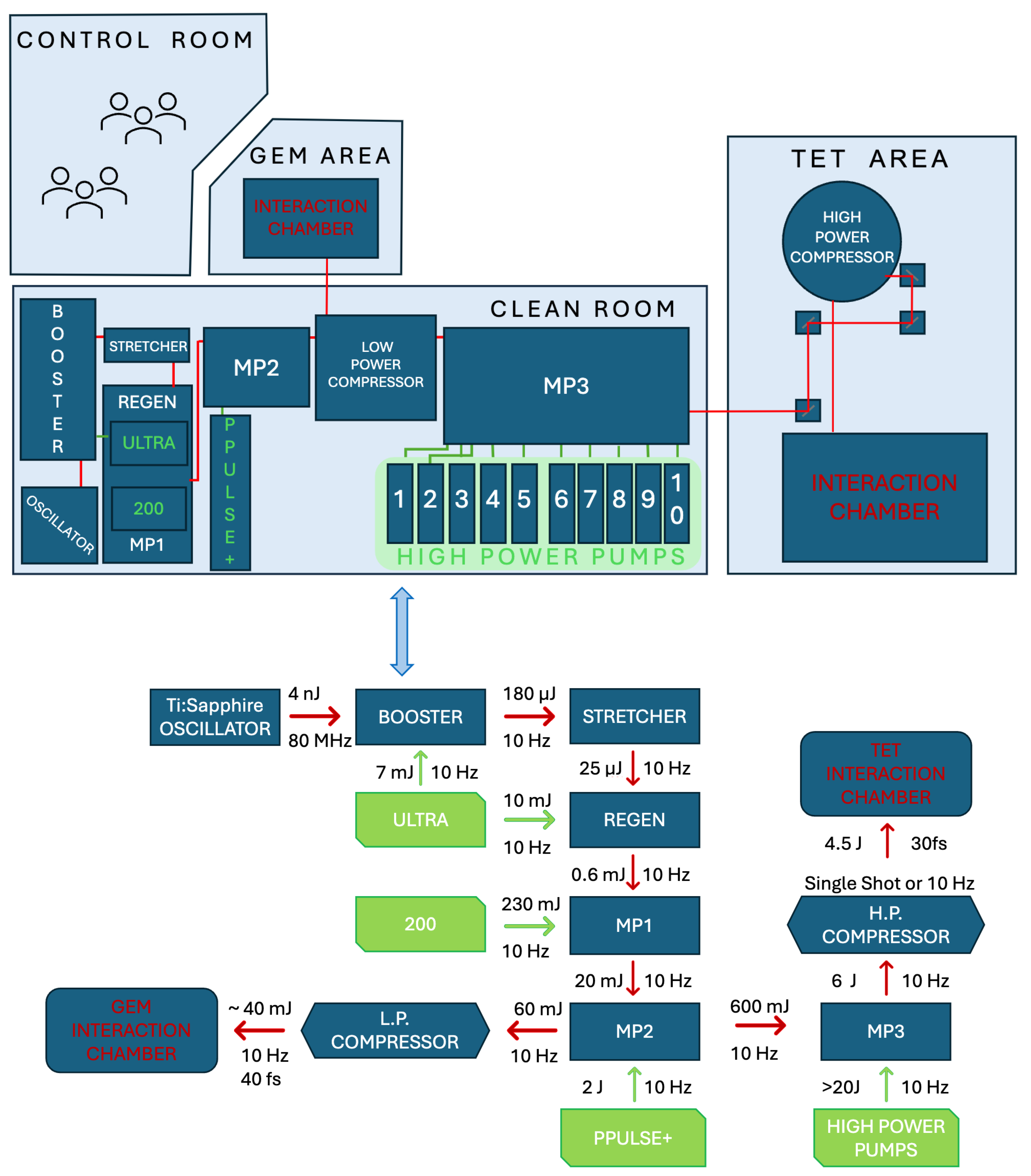
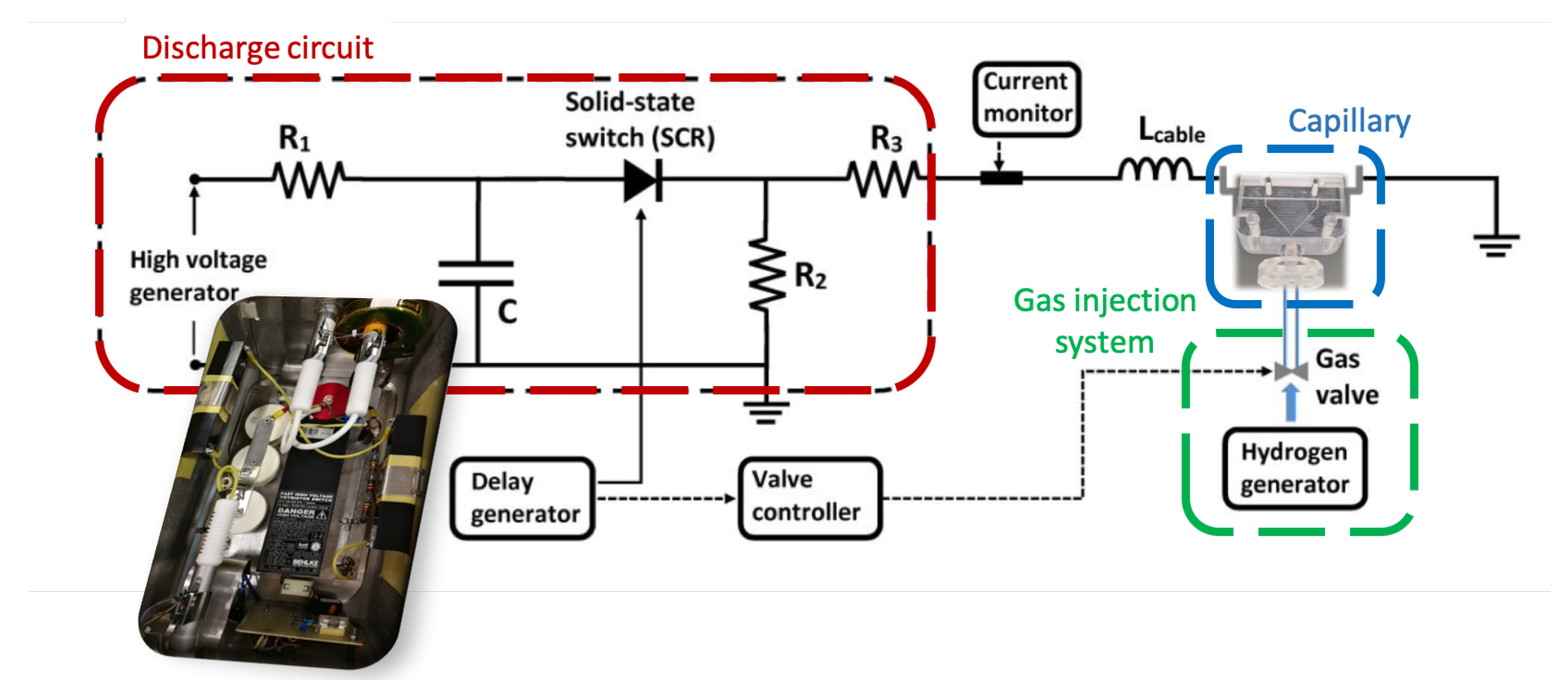
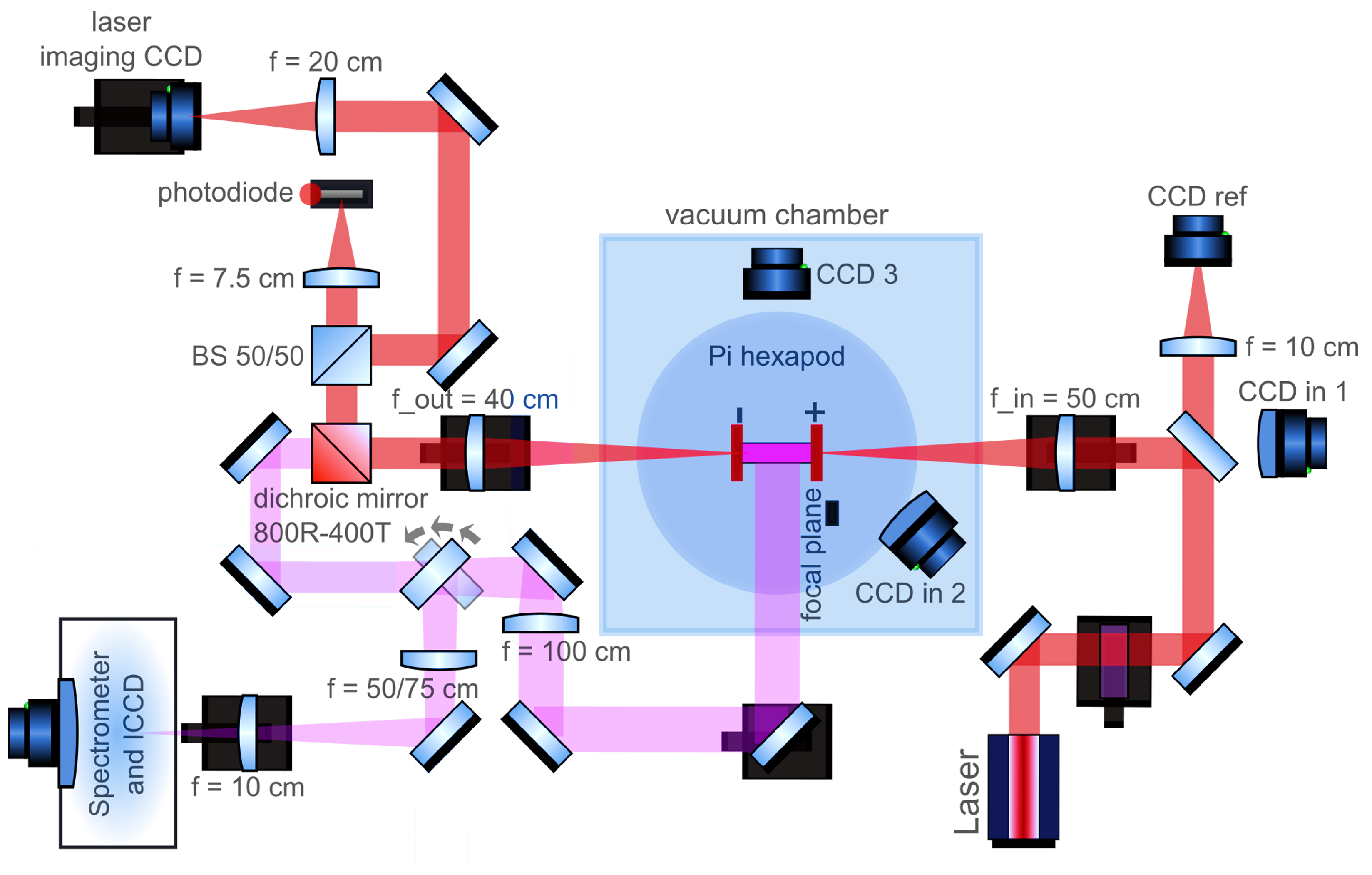



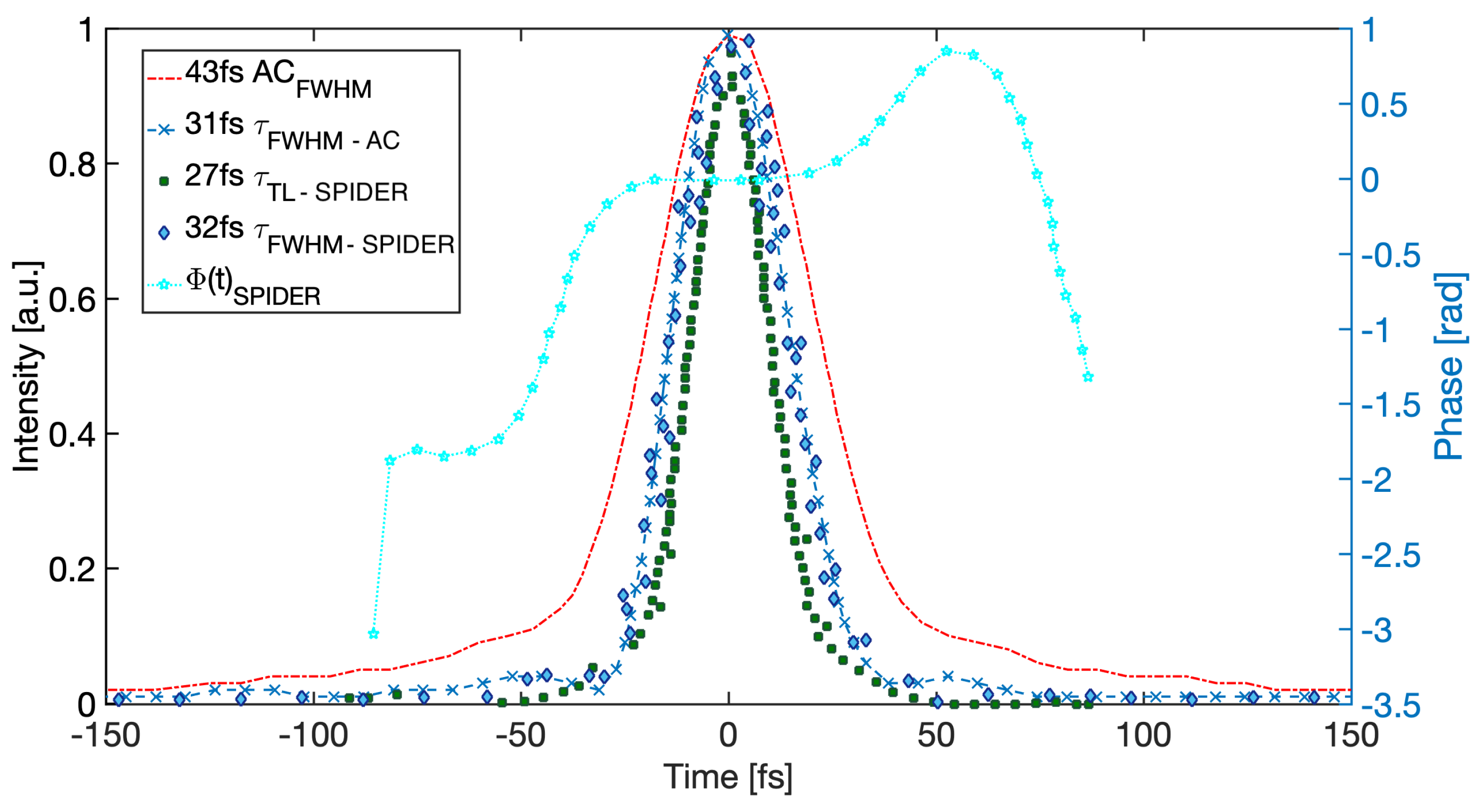
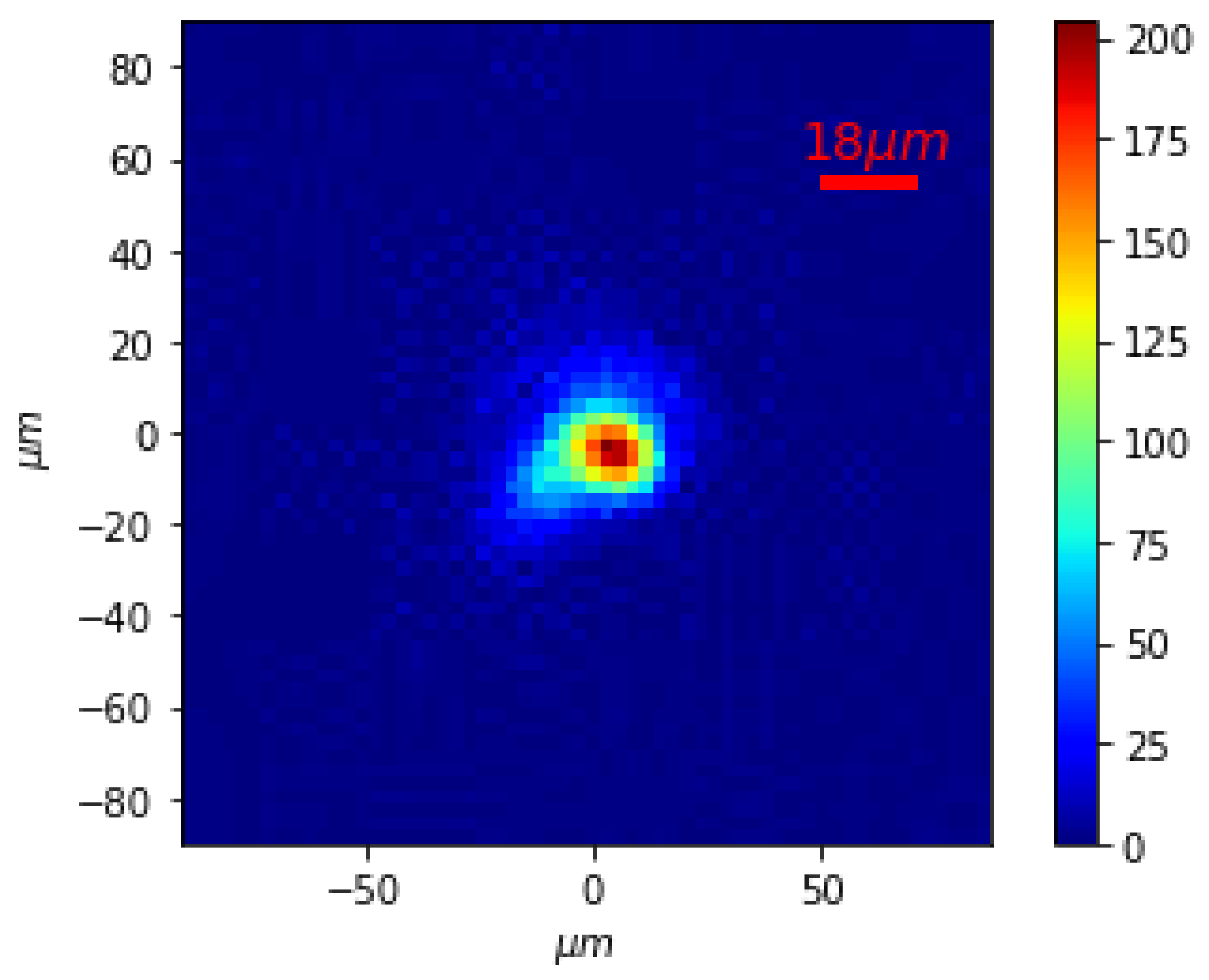
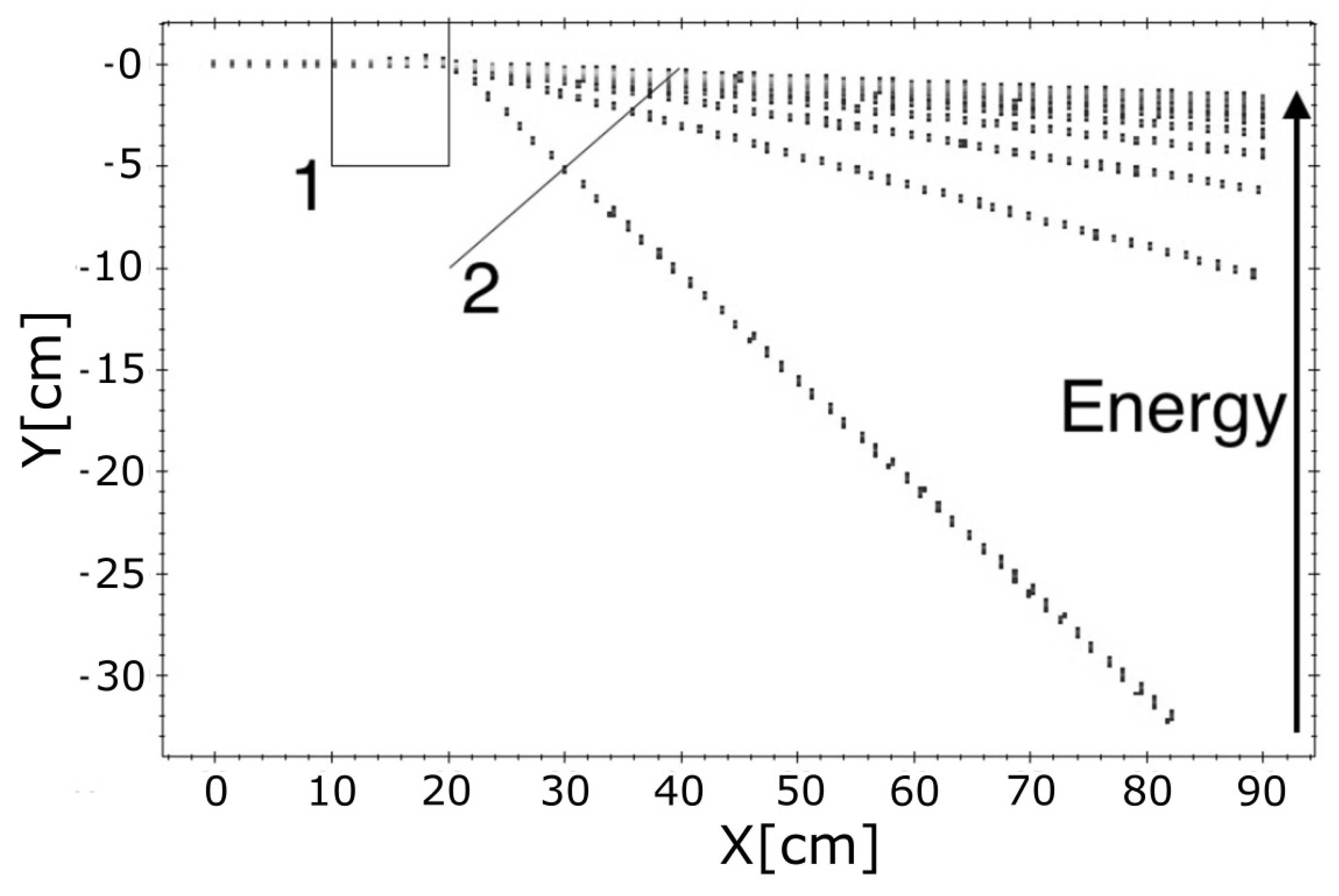

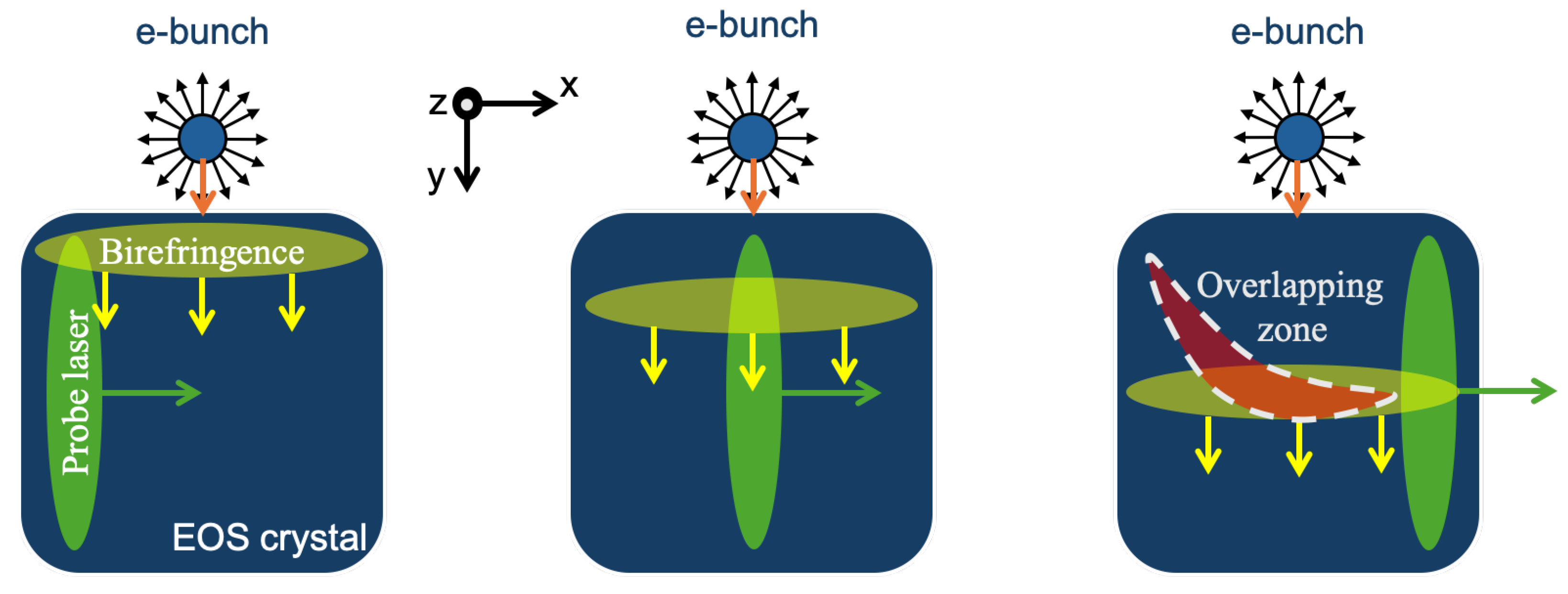
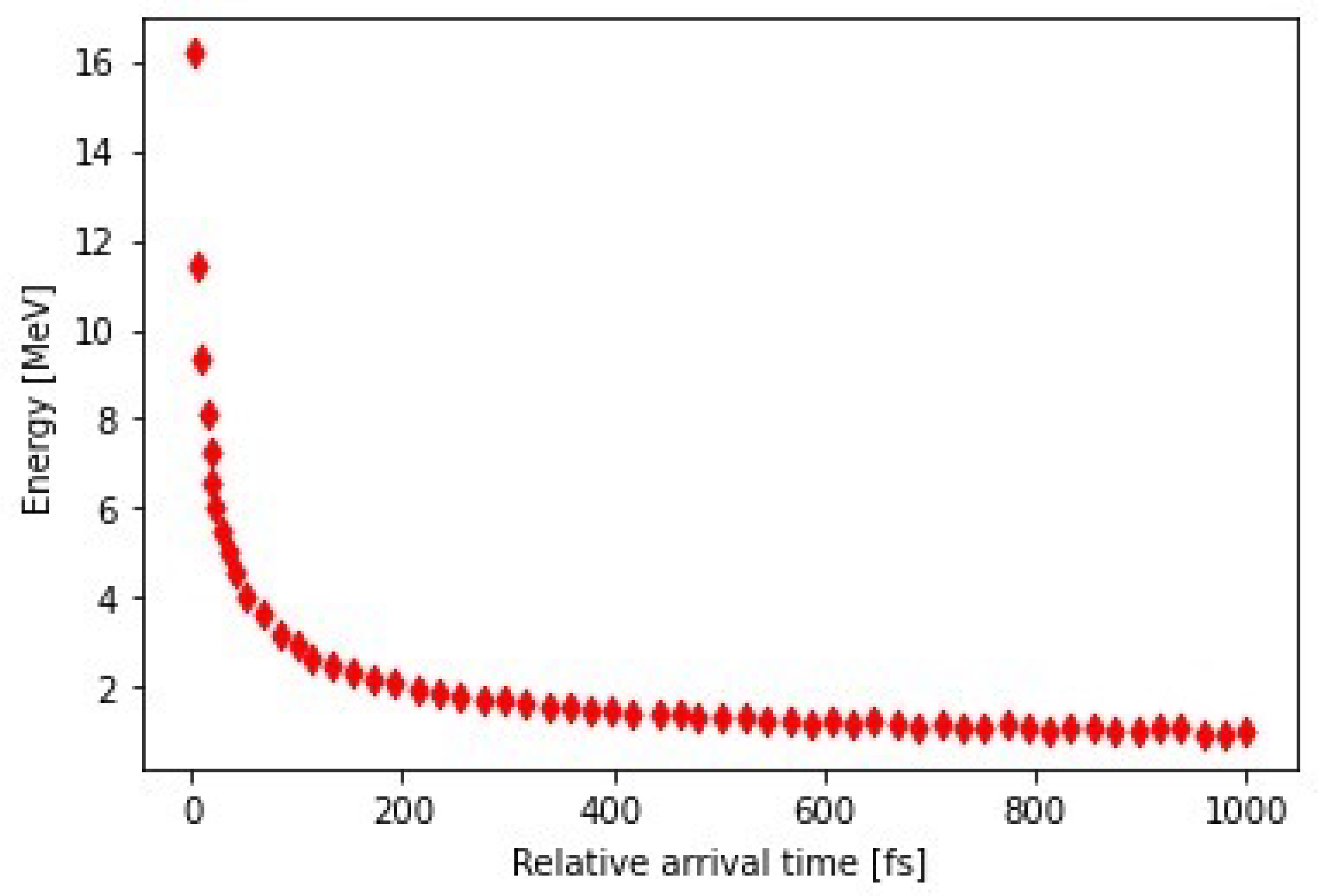

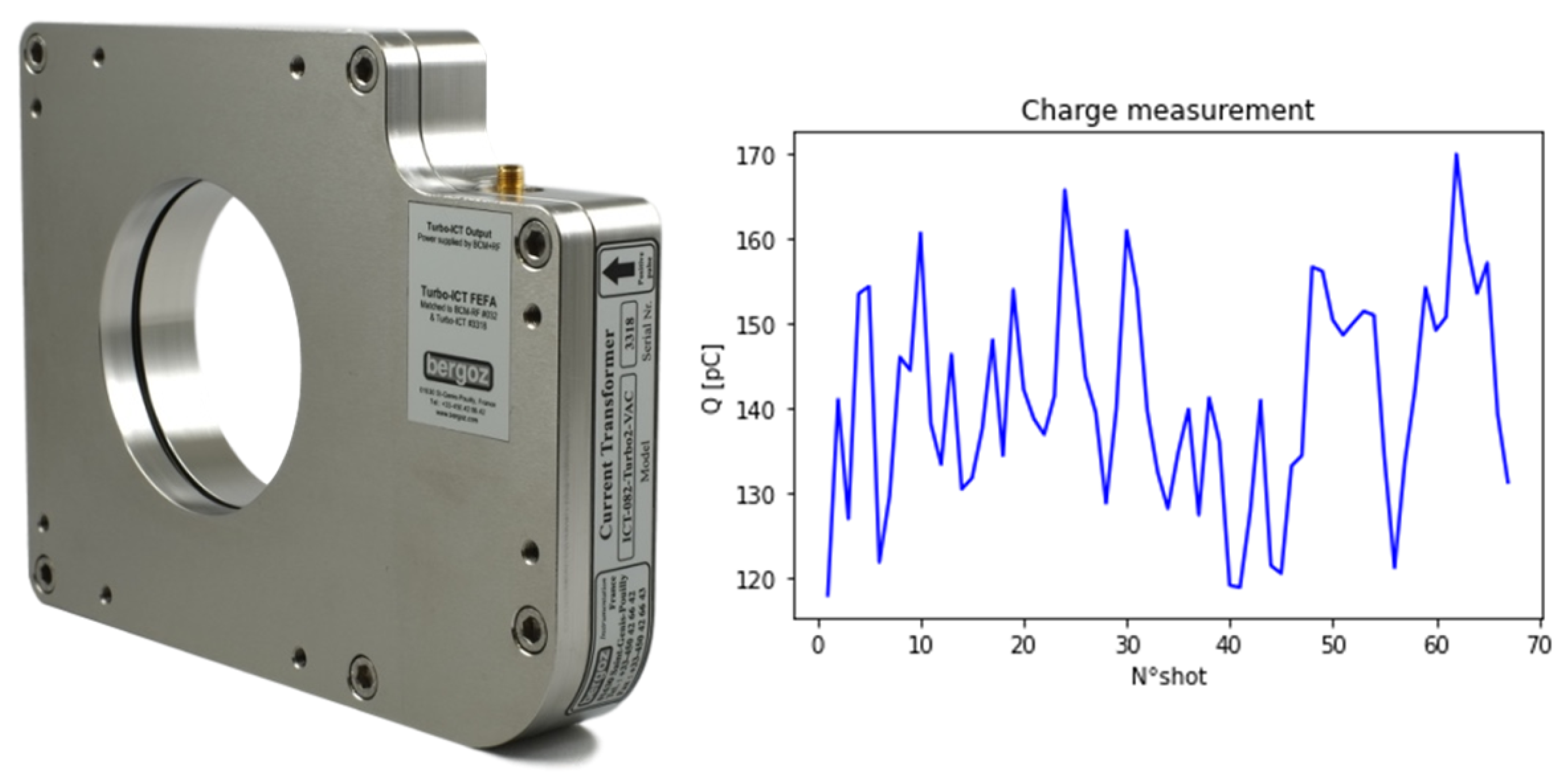
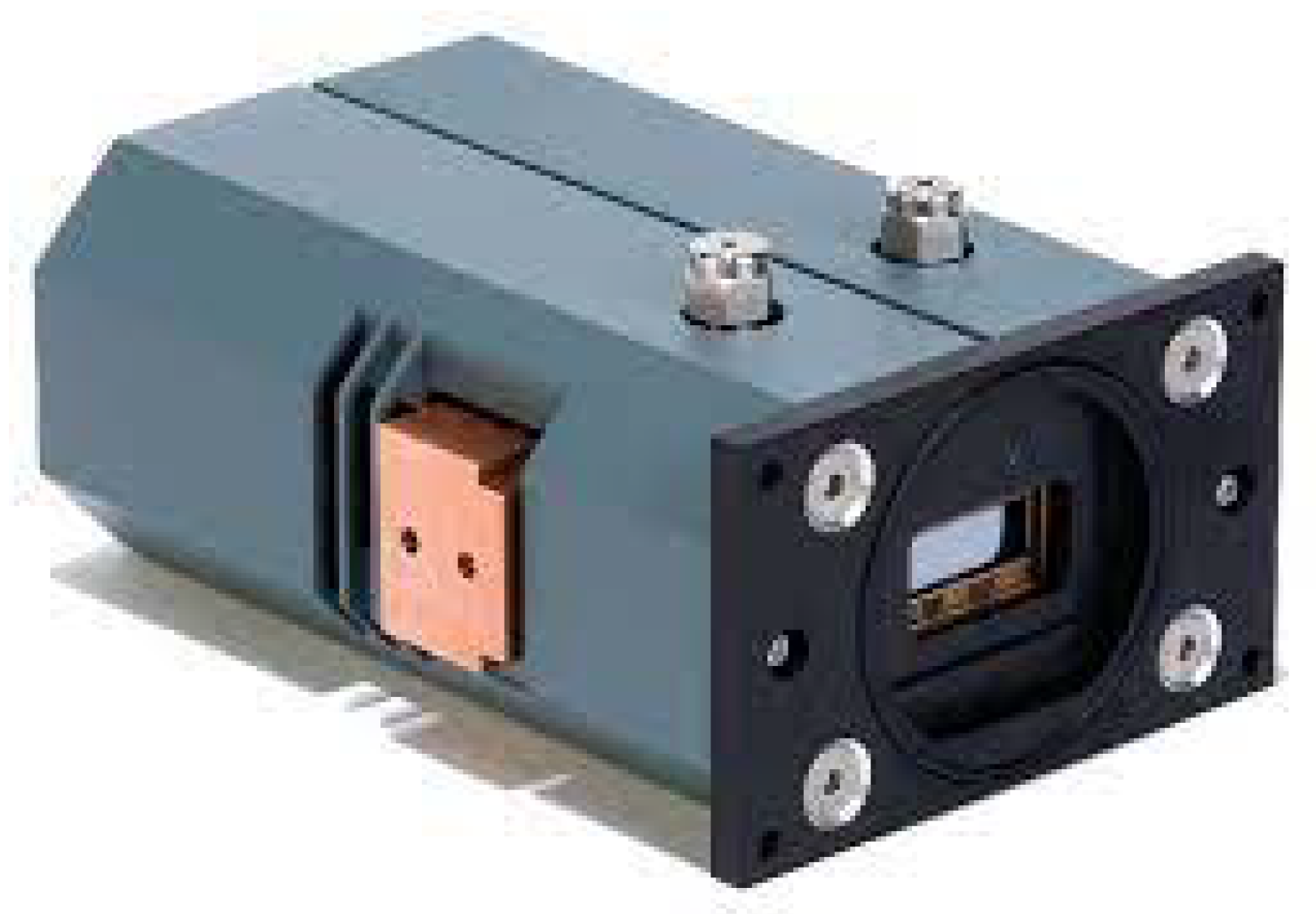
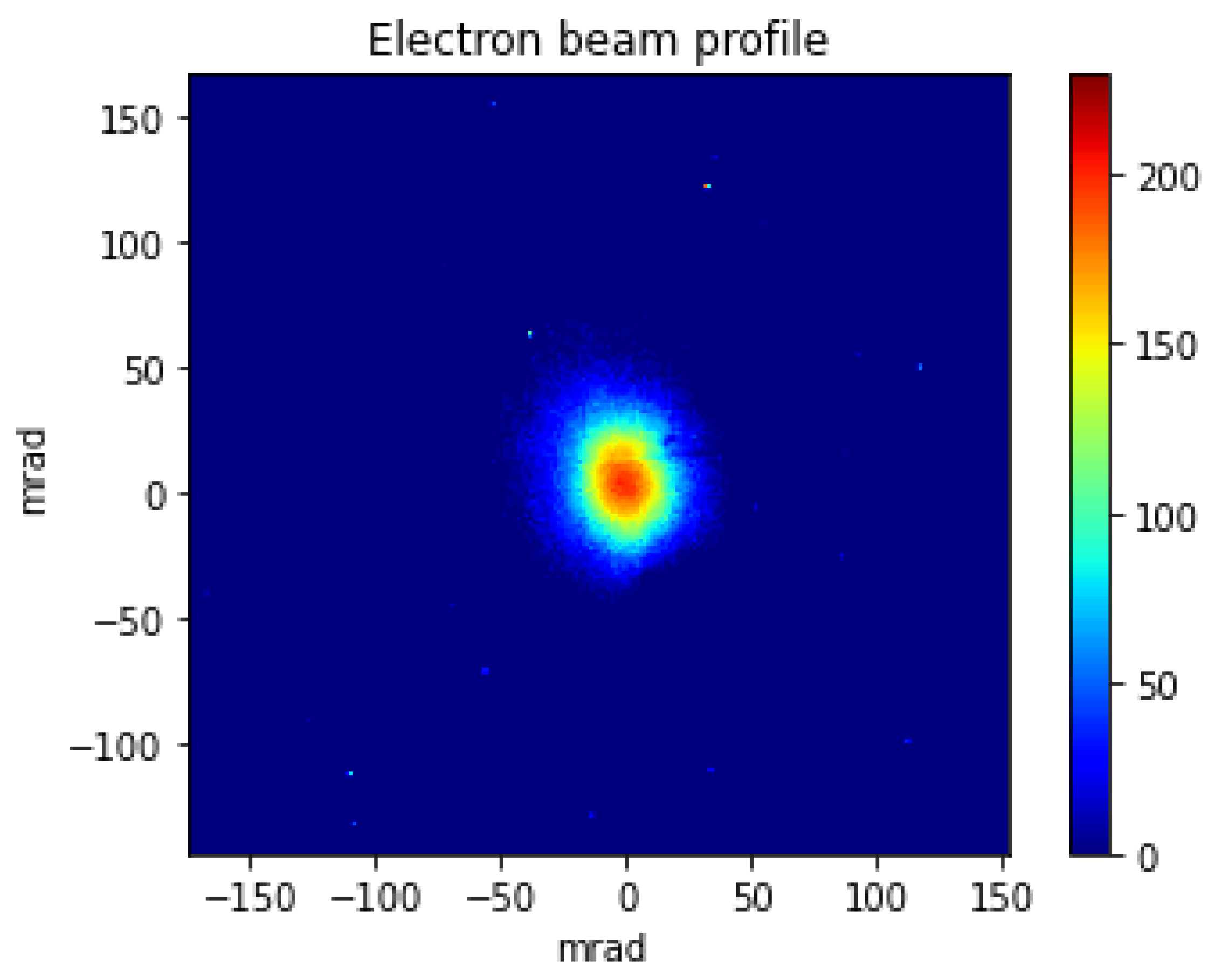
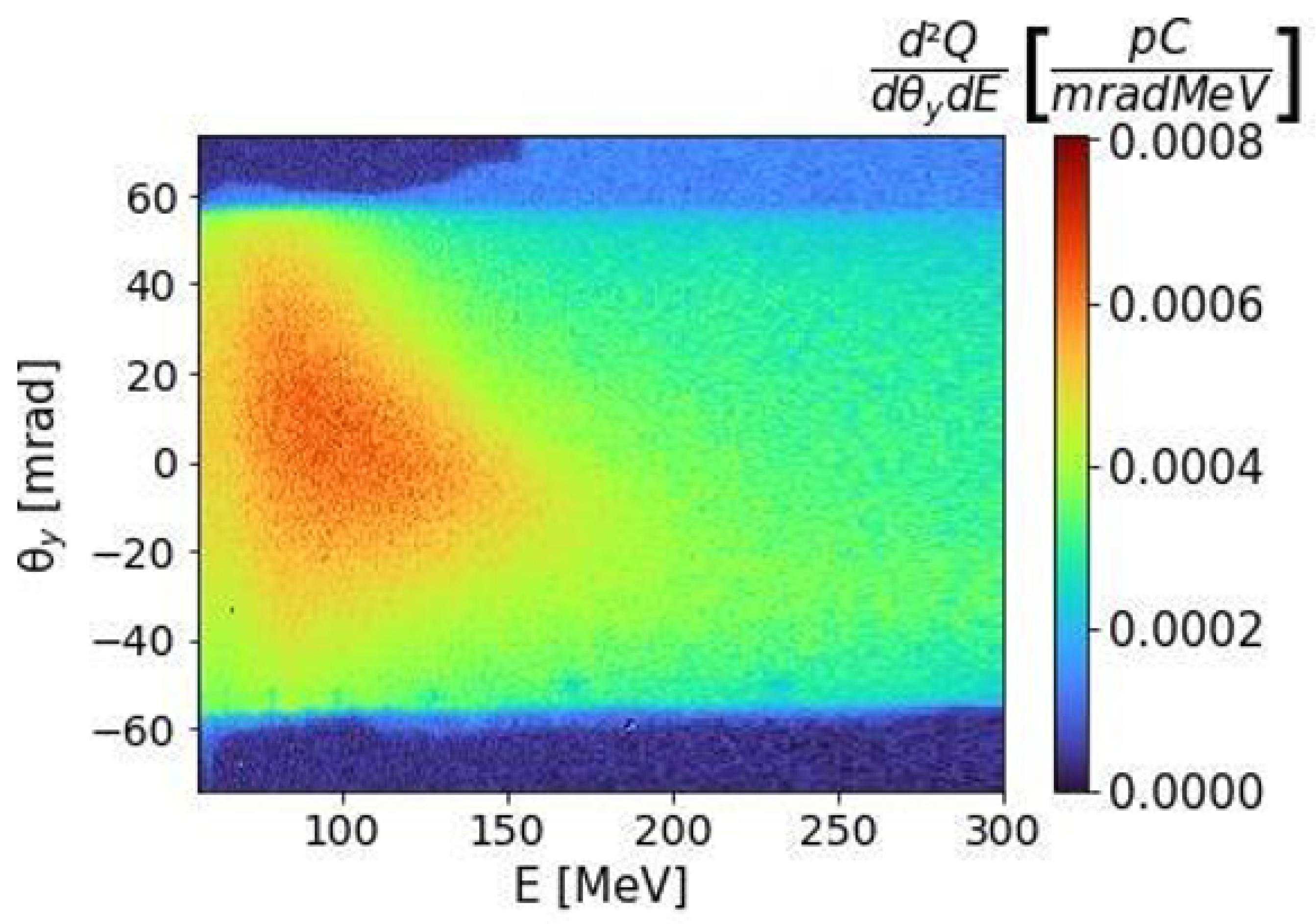

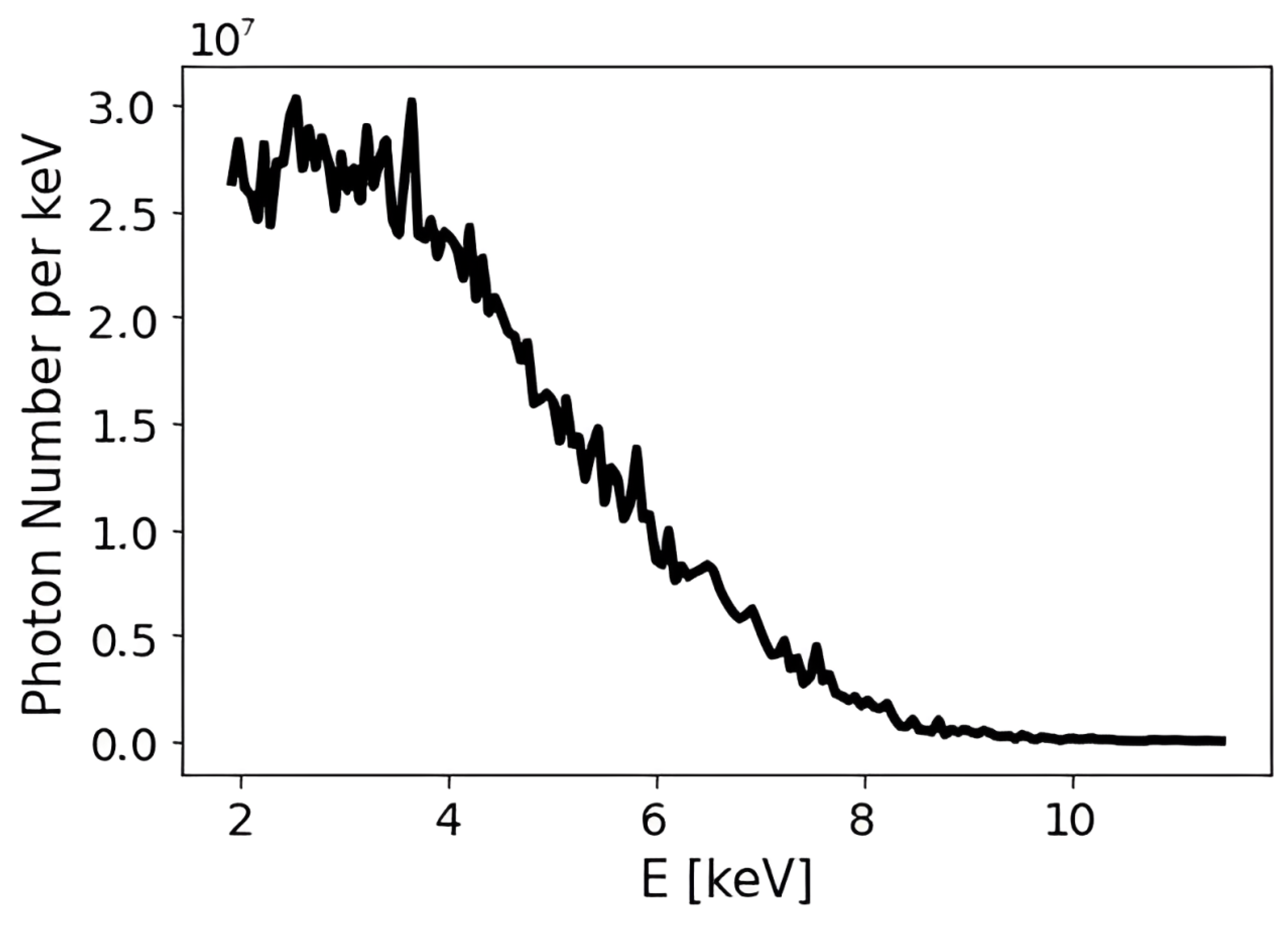




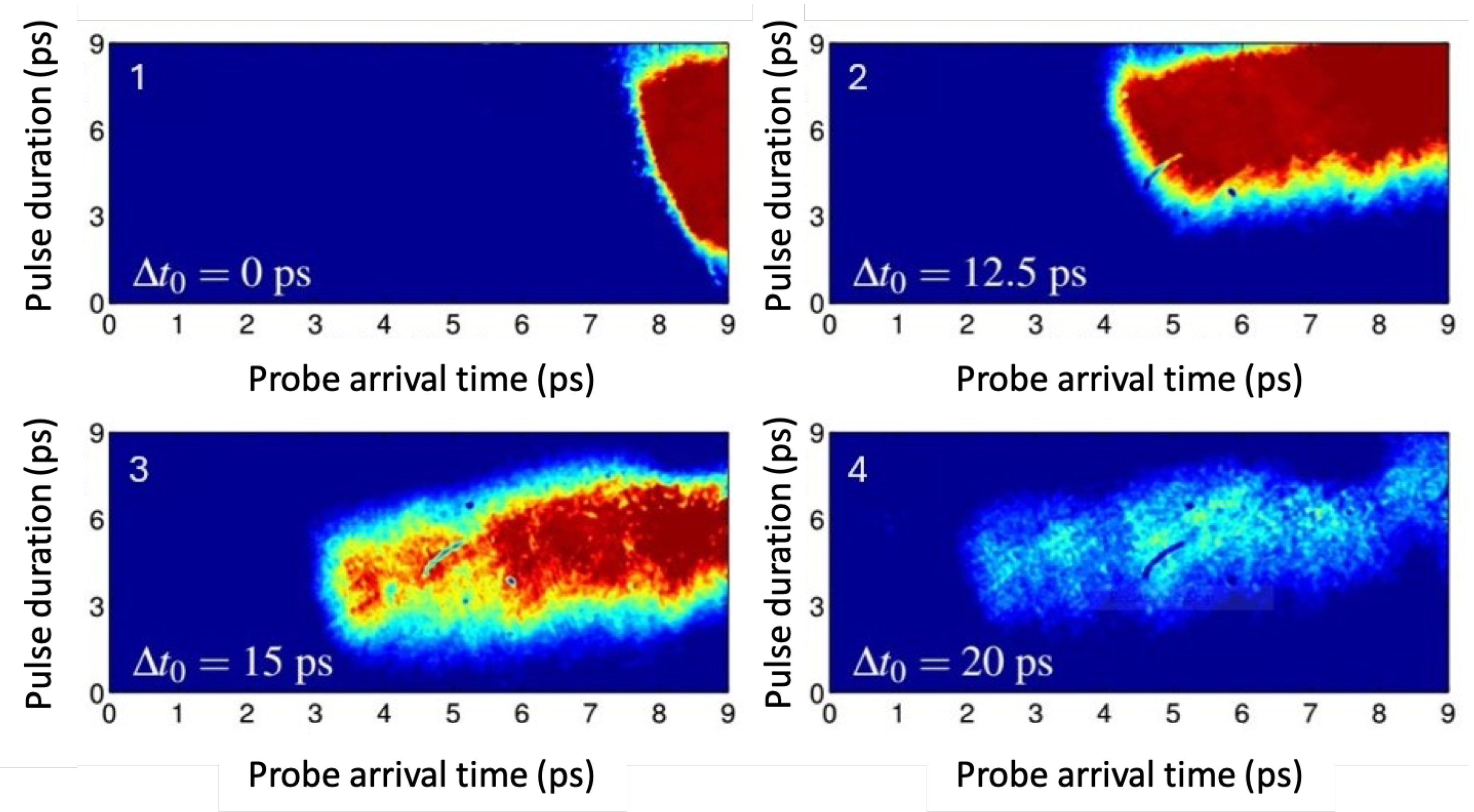


| Beamline | E (mJ) | (fs) | RR (Hz) |
|---|---|---|---|
| SHORT-HRR | |||
| Auxiliary and | 1–40 | 40 | 1–10 |
| Probe beams | |||
| LONG-HRR | 60 | – | 10 |
| Auxiliary beam | |||
| SHORT-LRR | 30 | 1 | |
| Main beam |
Disclaimer/Publisher’s Note: The statements, opinions and data contained in all publications are solely those of the individual author(s) and contributor(s) and not of MDPI and/or the editor(s). MDPI and/or the editor(s) disclaim responsibility for any injury to people or property resulting from any ideas, methods, instructions or products referred to in the content. |
© 2024 by the authors. Licensee MDPI, Basel, Switzerland. This article is an open access article distributed under the terms and conditions of the Creative Commons Attribution (CC BY) license (https://creativecommons.org/licenses/by/4.0/).
Share and Cite
Galletti, M.; Stocchi, F.; Costa, G.; Curcio, A.; Del Giorno, M.; Pompili, R.; Cacciotti, L.; Di Pirro, G.; Dompè, V.; Verra, L.; et al. Overview and Recent Developments of the Frascati Laser for Acceleration and Multidisciplinary Experiments Laser Facility at SPARC_LAB. Appl. Sci. 2024, 14, 8619. https://doi.org/10.3390/app14198619
Galletti M, Stocchi F, Costa G, Curcio A, Del Giorno M, Pompili R, Cacciotti L, Di Pirro G, Dompè V, Verra L, et al. Overview and Recent Developments of the Frascati Laser for Acceleration and Multidisciplinary Experiments Laser Facility at SPARC_LAB. Applied Sciences. 2024; 14(19):8619. https://doi.org/10.3390/app14198619
Chicago/Turabian StyleGalletti, Mario, Federica Stocchi, Gemma Costa, Alessandro Curcio, Martina Del Giorno, Riccardo Pompili, Luciano Cacciotti, Giampiero Di Pirro, Valentina Dompè, Livio Verra, and et al. 2024. "Overview and Recent Developments of the Frascati Laser for Acceleration and Multidisciplinary Experiments Laser Facility at SPARC_LAB" Applied Sciences 14, no. 19: 8619. https://doi.org/10.3390/app14198619
APA StyleGalletti, M., Stocchi, F., Costa, G., Curcio, A., Del Giorno, M., Pompili, R., Cacciotti, L., Di Pirro, G., Dompè, V., Verra, L., Villa, F., Cianchi, A., Anania, M. P., Ghigo, A., Zigler, A., & Ferrario, M. (2024). Overview and Recent Developments of the Frascati Laser for Acceleration and Multidisciplinary Experiments Laser Facility at SPARC_LAB. Applied Sciences, 14(19), 8619. https://doi.org/10.3390/app14198619













